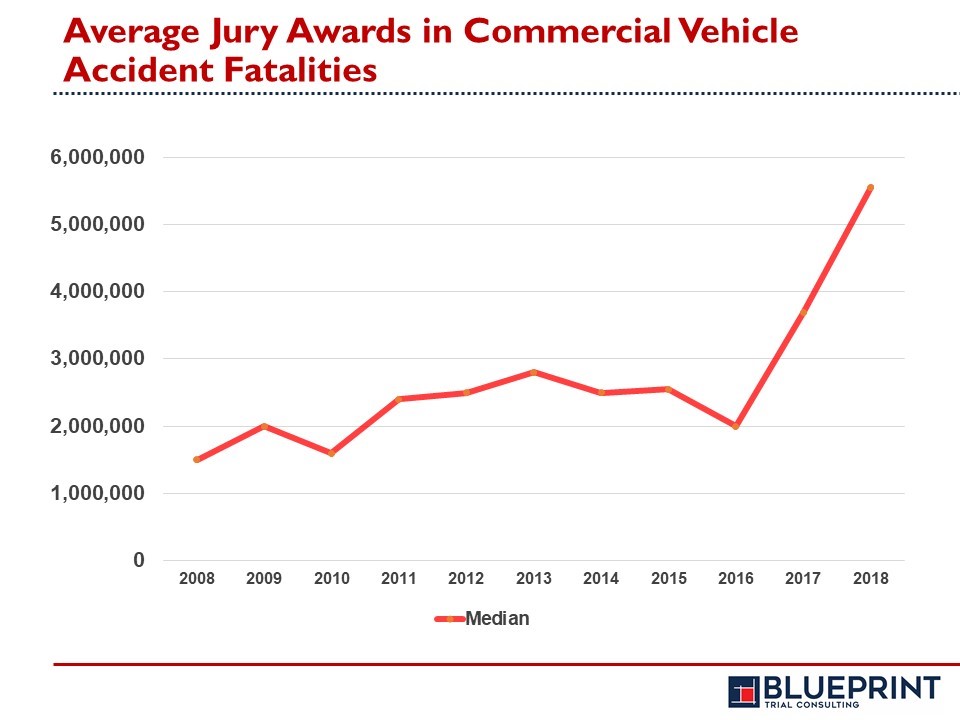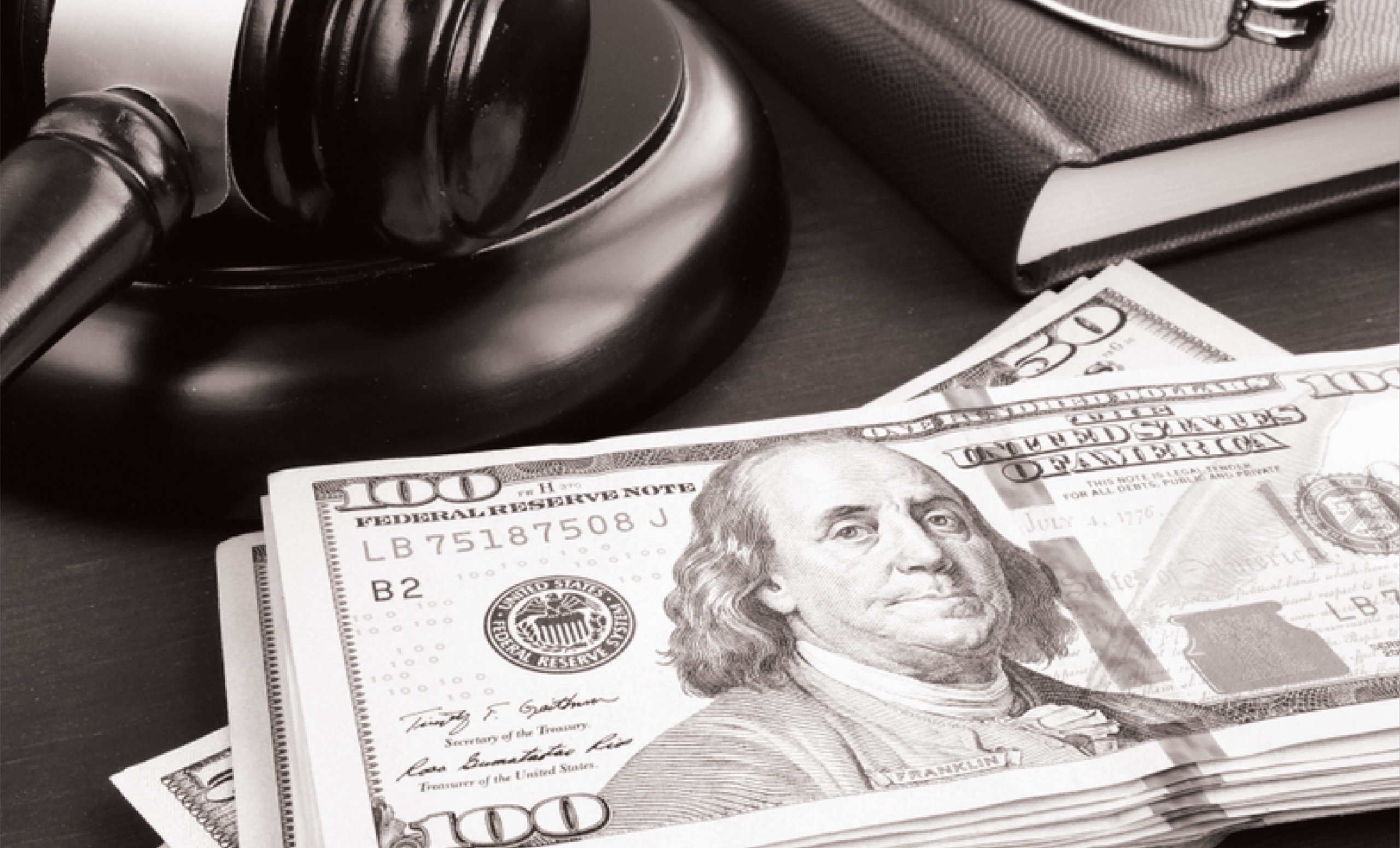Strategies to Combat Social Inflation and Plaintiff Litigation Tactics in the New Decade
The 2010s may be someday viewed as the decade of the plaintiff bar. Over the last decade there was a deluge of very large damages verdicts. The well-known McDonald’s coffee spill trial in 1994 which resulted in a $3 million verdict appears reasonable in light of the spate of verdicts in recent years that were over tens or hundreds of millions of dollars. The results of our aggregated analysis of verdicts in the past decade show that the median jury verdict award has increased significantly. Many attorneys and insurance claims professionals attribute the increase in verdicts to “social inflation” and plaintiff reptile strategies. The data support this trend. In 2008, the year before publication of the “Reptile: the 2009 Manual of the Plaintiff’s Revolution” the median damage awarded by juries nationally in cases involving a commercial vehicle fatality was $1,500,000. In 2018, the median award in these cases increased 367% to $5,500,000.
 Social inflation is a term among insurance professional and defense attorneys to explain why jury verdicts are increasing. In 2010, PartnerRe published a white paper describing social inflation as “an increase in insurance losses caused by such factors as higher jury awards, more liberal treatment of claims and new concepts of tort and negligence.”[i] A more recent article expanded this definition to include the increasing use of trials, the growing trend of third-party litigation funding, the availability and analysis of attorney data and tactics, changing views of social responsibility coupled with the erosion of trust in corporate America, the increased use of legal advertising, and the rise in populist sentiment.[ii]
Social inflation is a term among insurance professional and defense attorneys to explain why jury verdicts are increasing. In 2010, PartnerRe published a white paper describing social inflation as “an increase in insurance losses caused by such factors as higher jury awards, more liberal treatment of claims and new concepts of tort and negligence.”[i] A more recent article expanded this definition to include the increasing use of trials, the growing trend of third-party litigation funding, the availability and analysis of attorney data and tactics, changing views of social responsibility coupled with the erosion of trust in corporate America, the increased use of legal advertising, and the rise in populist sentiment.[ii]
Plaintiff attorneys are also utilizing litigation tactic known as “the reptile strategy” to increase damages awards. Borrowing from marketing psychology, the Reptile Theory was popularized in a 2009 book written by a plaintiff’s attorney and a jury consultant. Its premise was that the plaintiff’s bar could drive up jury verdicts by appealing to the “reptilian” primitive part of the brain of jurors by psychologically placing them in a position where they felt threatened, anxious, or potentially at risk of harm.[iii] The theory posits that the focus must be on the defendant’s violation of a “safety rule,” which motivates jurors to award large damages against a corporate defendant that has violated a safety rule and needlessly endangered the community.
In the past decade, plaintiff attorneys are also utilizing data analytics and jury research to maximize the value of their cases. For example, in an interview with Above the Law, a plaintiff’s attorney was quoted as stating “we work up our cases in other creative ways. For example, the first floor of my office has a mock trial focus group room with a viewing room and A/V hookups to watch mock juror deliberations from other rooms in the office. When we get some theory that we want to test, we run a focus group on it.”[iv] Plaintiff’s Magazine, a well-known plaintiff bar resource touts the utility of mock trials and focus groups and encourages plaintiff attorneys to invest in this resource noting that “Common sense dictates that the more information you have about what your mock jurors (those people most similar to the “real” jurors) find persuasive, the more you will know about what will likely convince your real jurors.”[v]
A 2019 article in The American Association for Justice discusses a plaintiff attorney group, “The Jury Bias Litigation Group,” established in 2008 because “too often plaintiffs lose cases they should win. These cases are often lost due to jury bias, not the actual strength of the evidence.” The group’s mission is “to exchange cutting-edge research so attorneys can minimize the effects of jury bias and tort ‘reform’ rhetoric” and provides members with information and advice about focus groups, mock juries, and jury consultants as well as other resources including a document library, list server, and educational programs.[i]
In summary, we are seeing the plaintiff bar using data analytics and jury research as well as leveraging jurors’ mistrust of corporations to obtain nuclear verdicts. Below are recommendations for reversing the tide of rising verdicts, reducing litigation risk, and lowering defendants’ damages exposure.
Recommendations
Although these nuclear verdicts may be later reduced or reversed on appeal or settled post-verdict, insurance companies will still spend significant funds defending, trying, and ultimately appealing these cases. Moreover, a runaway verdict sets a higher bar from which to later settle a case. Accordingly, solutions should be multifaceted and designed to focus on awareness of bias in defending these cases, recognition of the cultural zeitgeist that leads to higher verdicts, as well as an understanding and use of technology, risk management and early identification tools available to insurance companies and corporate defendants. Some of the early intervention and risk management strategies which have been shown to be effective, are jury research, mock trials, and focus groups which, as mentioned above, are being utilized by the plaintiff’s bar. There has been a concerted, coordinated effort by plaintiff organizations, as well as significant funding of these cases to give them the education and financial support to use these resources. Discussed in more detail below, jury research, mock trials, and focus groups allow plaintiff lawyers, not only to evaluate the monetary value of their cases, but also to test, practice, and refine their themes, case theories, witness testimony, and other evidence.
Recognize Confirmation Bias
Confirmation bias is the tendency for people to search for, interpret, favor and recall information that confirms their preexisting beliefs. Conversely, information that supports a different viewpoint is likely to be dismissed or ignored.

As advocates for their clients, attorneys spend a great deal of time reviewing the evidence and the law in order to present their case in the most favorable light. Attorneys are continually advocating for their client during discovery, while writing briefs, arguing motions, participating in settlement negotiations, and throughout trial. As attorneys work on a case, there is truth to the adage that there is a tendency to “fall in love with one’s case.” Confirmation bias occurs when facts uncovered in discovery are interpreted in a way most favorable to their client and are given disproportionate importance while facts which are unfavorable are disregarded or given less significance and weight. Confirmation bias can negatively impact litigation and the ultimate outcome of the case. An attorney may disregard or dismiss important facts which do not confirm or easily fit with his or her theory of the case. These disregarded facts, however, may be persuasive to a judge, mediator or jury. An attorney also may give less weight to a seemingly irrelevant fact or an emotional argument, not objectively appreciating how a particular element of a case may impact a jury. Attorneys and/or their clients may become enamored by the facts supporting their theory that an opportunity for productive settlement discussions will be lost, or an unrealistic valuation of the case will prevent resolution. Regarding attorney confirmation bias, throughout the litigation it is crucial to engage in “perspective shifting.” This may be accomplished by attorneys listing the most positive and persuasive points of their adversary’s case and the most negative points of their case. Attorneys may evaluate and even argue their adversary’s case in order to see the case more objectively.
Recognize the Cultural Zeitgeist
Awareness of the cultural zeitgeist is critical to an unbiased evaluation of your case. The same case can yield completely different results depending upon when the case is tried. For example, a sexual harassment case in the 1990s, may yield a much different result than one tried today. For years after the McDonald’s coffee spill verdict mentioned above, we observed mock jurors mentioning this case as an example of runaway verdicts. We rarely here this case mentioned today. In sum, awareness of shifting juror attitudes is critical in litigation strategy if the facts of your case may be positively or negatively affected. Jury research and mock trials assist you to gain an understanding how the current culture and jurors’ attitudes may impact their case-related perceptions and verdicts.
Jury Research and Mock Trials
In an era of social inflation where plaintiffs use third-party funding, reptilian trial strategies, and jury research, it is critical to evaluate cases at an early stage often before mediation or settlement negotiations. Accidents resulting in catastrophic injuries and fatalities elicit a great deal of sympathy and have high verdict potential regardless of whether jurors believe that the defendant is liable. Jurors today believe that plaintiffs should receive compensation regardless of a defendant’s liability because they have deep pockets. In these cases, will your juries’ judgment be clouded with emotion or will they be able to separate the questionable liability from catastrophic damages? To have a productive settlement discussion, it is advantageous to determine whether a jury will believe your liability arguments and to obtain feedback on case value. In addition to mock trial, focus groups, and other types of jury research, early case assessment tools can also provide a comprehensive overview of comparable jury verdicts, an analysis of the venue, and the plaintiff’s effectiveness in other trials. These types of pre-mediation tools will more likely result in an earlier more efficient settlement which will result in lowering overall litigation related expenses.
Conclusion
Will there continue to be an increase in jury verdict awards in the 2020s? We will continue to see changes in technology and juror attitudes in the new decade. Moreover, as many people become less connected to corporations and work in the gig economy, jurors may continue to become less connected to corporations viewing them as financial behemoths that should generously compensate plaintiffs. An understanding of the factors causing social inflation, the recognition of the plaintiff bar’s commitment to utilizing in jury research and data analytics may also be used by defendants to evaluate case risk and more efficiently resolve cases in the new decade.
i] https://partnerre.com/opinions_research/social-inflation-in-the-u-s-what-is-it-and-why-is-it-a-concern/
[ii] https://www.captive.com/news/2019/10/30/five-thoughts-on-social-inflation
[iii] Reptile: The 2009 Manual of the Plaintiff’s Revolution
[iv] https://abovethelaw.com/2015/10/3-reasons-for-choosing-plaintiffs-law-over-defense-law/
[v] https://www.plaintiffmagazine.com/recent-issues/item/mock-trials-for-solos-and-small-firms
[vi] https://www.justice.org/litigation-groups/jury-bias



